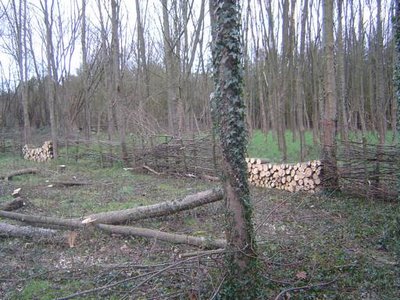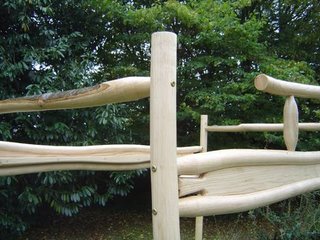
Can’t see the wood for the trees. First there was a dream, then a cunning plan, and some impetuosity and now it’s all hard work! I first told you about the woodland back on 19th July and then gave you an update on November 12th. We came across 4.5 hectares / 11acres of mixed woodland for sale while searching for a place to live. We wanted a building plot for our planned straw bale eco-home and enough agricultural land for our permaculture dreams of fruit, vegetables and animals. This combination (of building plot with enough land) proved elusive so we looked at anything at all promising and the woodland was for sale with a building plot and 17th century presbytery. The building and plot weren't right for us but when we did find our home nearby and realised we still had some money left in our pockets, we remembered the woodland. At first, we tried to be very logical about it and attempt to justify its purchase in economic terms but realised that, above all, every time we went for a walk in the woods to ponder whether we should buy it, we ended up with big smiles on our face. Then we got all dreamy and thought of all the things we could do with the woodland; that was the easy bit!
Having signed for it, we then needed a management plan for it which, for us, meant a permaculture plan. Our first point of reference has always been Ben Law’s The Woodland Way: A Permaculture Approach to Sustainable Woodland Management and my course notes from his introduction to permaculture and assessing a woodland course that I did a couple of years ago. You can download and read our permaculture design proposal by clicking here. Basically, two of the planted species are wrong for the location and therefore have not been a success, the sycamore maples especially are already showing signs of exhaustion. No access routes were planned or maintained by the last owner and the largest trees, some Larriscio Pines, are the furthest away from the road. The woodland is not large enough to earn its keep from conventional high forestry management and so permaculture solutions were needed. It’s expensive to create rides (access ways) in the woodland large enough to take the large machines necessary to harvest and cart away fully grown trees and this would also involve bridging several drainage ditches. But if the cut lumber were of a size that it could be carried out on a shoulder things would be altogether easier. Rather than selling the raw commodity too cheaply, we could add value to some of the wood by turning it into something else first, anything from the bed (see photo) made by our friend Jim from the first sycamore we cut down, through to artists’ charcoal; it will also provide for all of our heating needs for the rest of our lives.
Rather than selling the raw commodity too cheaply, we could add value to some of the wood by turning it into something else first, anything from the bed (see photo) made by our friend Jim from the first sycamore we cut down, through to artists’ charcoal; it will also provide for all of our heating needs for the rest of our lives.
One of the expert forestiers, Monsieur Eon, pointed out to me many ash and oak saplings which had germinated naturally, hence it is nature—the soil and the conditions—which are choosing what’s right for this site. Our plan is therefore to work with nature to turn the woodland into coppice, with ash, hazel and (trying this year to see if the tree likes the soil) sweet chestnut, all under oak standards. The wood than then be harvested on a cycle of say seven years, yielding poles that can easily be carried out manually to be used to make things, like the ash yurt frame pictured. And the impetuosity I mentioned? When talking to Alain at a nursery near here in Broons, on the spur of the moment, I ordered 50 saplings each of ash, hazel and sweet chestnut. To coppice correctly, one must clearfell at least 0.12 of a hectare (1/3 of an acre) to allow enough sun in to promote re-growth; if individual trees were cut, when the surrounding trees leafed up in the Spring, the stump (or stool in coppice terminology) would die. It’s already later than ideal to plant saplings and a job really to be done in winter, which used to include February, but it appears Spring is already here and so I’m frantically trying to cut down a quarter of a hectare (2/3 of an acre) of sycamore trees so we can plant those saplings.
And the impetuosity I mentioned? When talking to Alain at a nursery near here in Broons, on the spur of the moment, I ordered 50 saplings each of ash, hazel and sweet chestnut. To coppice correctly, one must clearfell at least 0.12 of a hectare (1/3 of an acre) to allow enough sun in to promote re-growth; if individual trees were cut, when the surrounding trees leafed up in the Spring, the stump (or stool in coppice terminology) would die. It’s already later than ideal to plant saplings and a job really to be done in winter, which used to include February, but it appears Spring is already here and so I’m frantically trying to cut down a quarter of a hectare (2/3 of an acre) of sycamore trees so we can plant those saplings. Oh, and one other minor point: once I started cutting the sycamore trees down, I could then see the wood - hundreds of tiny ash saplings growing naturally and I've already ordered 50! The yellow “X” marks a tree to come down (a red circle warns me off the ones we’re keeping) and the photo at the top shows our (currently unfinished) attempt at some deer fencing to protect the new trees. Time to get back to the chainsaw!
Oh, and one other minor point: once I started cutting the sycamore trees down, I could then see the wood - hundreds of tiny ash saplings growing naturally and I've already ordered 50! The yellow “X” marks a tree to come down (a red circle warns me off the ones we’re keeping) and the photo at the top shows our (currently unfinished) attempt at some deer fencing to protect the new trees. Time to get back to the chainsaw!
